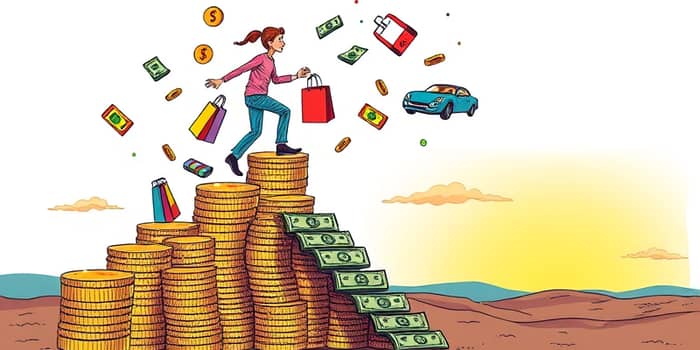As your income climbs, the allure of upgraded possessions and experiences can quietly erode your long-term goals. Recognizing the subtle pull of lifestyle inflation is the first step toward preserving the progress you’ve made and accelerating your path to freedom.
Understanding Lifestyle Inflation and Its Impact
Lifestyle inflation, sometimes called lifestyle creep, occurs when rising earnings lead to proportionally higher spending rather than increased savings. During major career milestones—graduation, promotions, or bonuses—people often feel justified in upgrading every aspect of their lives simultaneously.
Yet, despite higher paychecks, they may end up living paycheck to paycheck. The gap between take–home pay and true financial security can never widen if expenses inflate at the same rate as income.
The Psychology Behind Lifestyle Creep
Small changes can trigger a spending cascade. Upgrading to daily artisanal coffee, adding streaming subscriptions, or buying trend-driven clothing seems harmless at first. Over time, these habits accumulate into a significant outflow.
At its core lies the belief that material purchases equate to happiness, a mindset that creates a perpetual chase for the next upgrade. Recognizing this pattern empowers you to pause before every discretionary expense and question its true value.
Consequences of Unchecked Lifestyle Inflation
Allowing expenses to rise in tandem with income brings serious downsides:
- Financial vulnerability: Even high earners can feel strapped for cash if they spend every extra dollar.
- Diminished savings rates: Increased spending reduces the amount available for emergency funds, retirement, or investments.
- Debt accumulation: Reliance on credit cards or loans to sustain an inflated lifestyle leads to high-interest burdens.
- Delayed financial independence: Every unnecessary purchase pushes your freedom date farther into the future.
- Difficulty meeting major goals: Home purchases, education funds, and other objectives slip out of reach.
These outcomes create a feedback loop: the stress of overspending drives more impulsive buys, further eroding stability.
Effective Strategies to Avoid Lifestyle Inflation
With intentional planning, you can direct extra income toward growth instead of nonessential upgrades. Start by setting a clear framework that keeps expenses in check.
- Implement the 50/30/20 rule: allocate 50% to necessities, 30% to discretionary spending, and 20% to savings or debt repayment.
- Create a detailed budget that tracks every dollar, revealing areas of increased spending habits gradually before they spiral out of control.
- Automate contributions: set up automatic transfers to savings or investment accounts the moment you receive your paycheck.
- Use each paycheck increase as an opportunity to boost savings rates rather than expand your lifestyle.
- Prioritize paying down high-interest debt with a debt avalanche or snowball method.
Visualizing these percentages each month helps keep spending aligned with your objectives.
Balancing Enjoyment and Financial Responsibility
Every journey toward independence needs moments of celebration. Allocate a small fund for conscious rewards—dining experiences, travel adventures, or hobby-related purchases—while maintaining overall discipline.
Learn to value experiences over material goods by tracking how certain purchases impact your happiness over time. A weekend getaway may yield more lasting satisfaction than a fleeting luxury item.
Actionable Plan for Sustainable Financial Growth
Turn insight into action with this step-by-step approach:
- Assess current spending: identify categories where inflation is already creeping in.
- Establish a structured plan for future income increases that channels raises into savings and debt reduction first.
- Set up automatic reinvestment of bonus payments or windfalls into retirement or taxable investment accounts.
- Implement a 30-day waiting period for significant purchases to curb impulse decisions.
- Conduct quarterly financial reviews to measure progress, adjust targets, and celebrate milestones.
Embedding these habits early creates momentum, transforming occasional raises into exponential wealth growth.
Case Studies: Real Success Stories
Consider the story of Maya, who doubled her salary within three years but maintained her original apartment and vehicle. By directing each pay raise into a diversified investment portfolio, she achieved a six-figure nest egg before age 30 and now enjoys the freedom to work on passion projects.
Similarly, Julio chose to invest his annual bonuses rather than upgrade his living space. Within five years, his passive income covered all his living expenses, giving him the liberty to reduce his work hours and spend more time with family.
Conclusion
Avoiding lifestyle inflation is less about deprivation and more about conscious choice. By understanding the psychology driving spending, recognizing the hidden costs of upgrades, and implementing disciplined strategies, you can accelerate your journey to financial independence.
Let every pay rise become a catalyst for building your future, not simply elevating your present. With patience, planning, and persistence, true freedom is within reach.
References
- https://www.investopedia.com/terms/l/lifestyle-inflation.asp
- https://www.ohnwardbank.bank/obt/recognize-and-manage-lifestyle-inflation
- https://www.rocketmoney.com/learn/personal-finance/lifestyle-inflation
- https://www.align.financial/lifestyle-inflation-and-what-it-means-for-your-retirement-plan/
- https://www.datalignadvisory.com/avoid-the-lifestyle-inflation-trap-how-to-keep-growing-your-wealth-without-overspending/
- https://blog.vrid.in/2024/02/27/why-should-you-think-twice-before-upgrading-your-lifestyle-how-is-lifestyle-inflation-the-silent-killer-of-your-wealth/
- https://www.bankhillsboro.com/how-to-avoid-lifestyle-inflation-and-save-more-money/
- https://jackduffley.com/the-productive-kind-of-lifestyle-inflation/










